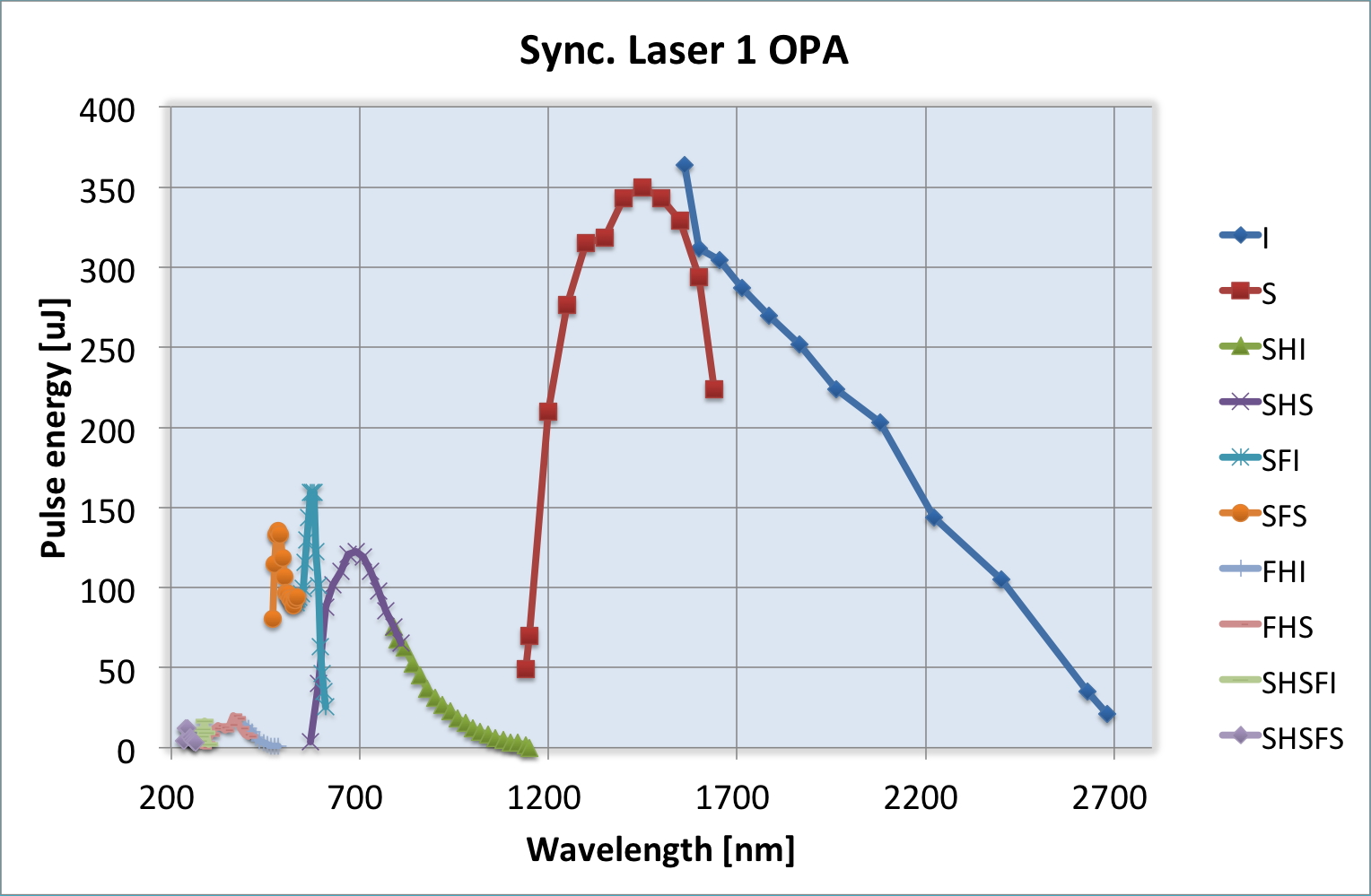
Instruments available at experimental stations
SACLA provides fundamental instruments such as focusing optics, synchronized optical lasers, and arrival timing monitor, which are permanently stationed in the experimental stations. In addition, various types of transportable instruments and X-ray detectors are available for user experiments. Users can also bring their own instruments. Available instruments and typical applications at each station are summarized in the table below.
BL3 experimental stations
| Focusing Optics (spot size) | Synchronized Optical Laser | Arrival Timing Monitor *1 | Typical Instruments | Typical Applications | |
| EH2 | Be-CRL (> 2 μmΦ) | CPA/OPA | Available | Multi-axis diffractometers DAPHNIS*2 | Ultrafast materials science Ultrafast chemistry SFX/FPX AMO |
| EH4c | 1μm KB mirror (~1 μmΦ) | CPA | Available | Multi-axis diffractometers | Ultrafast chemistry AMO Nonlinear/quantum optics |
| EH5 | 300exa KB mirror (~100 nm x 200 nm) | 300exa experimental system | Nonlinear/quantum optics | ||
| KB mirror for HP-NSL experiment (> 500 nmΦ) | High-power nanosecond laser (HP-NSL) | Experimental system for HP-NSL | HEDS |
BL2 experimental stations
| Focusing Optics (spot size) | Synchronized Optical Laser | Arrival Timing Monitor*1 | Typical Instruments | Typical Applications | |
| EH3/EH4b | 1μm KB mirror (~1 μmΦ) | Nanosecond green laser /Nanosecond OPO | DAPHNIS MAXIC*3 | SFX/FPX CDI | |
| EH6 | Be-CRL (> 2 μm2) | High-power femtosecond laser (HP-FSL) | Interaction chamber for HP-FSL*4 | HEDS Nonlinear/quantum optics |
*2) K. Tono et al., J. Synchrotron Rad. 22, 532-537 (2015). doi:10.1107/S1600577515004464
*3) C. Song et al., J. Appl. Cryst. 47, 188-197 (2014). doi:10.1107/S1600576713029944
*4) T. Yabuuchi et al., J. Synchrotron Rad. 26, 585 (2019). doi: 10.1107/S1600577519000882.
Focusing optics and focused beam parameters
| Typical Beam Size (FWHM, @10 keV) | Beam Divergence (FWHM, @10 keV) | |
| Unfocused (@OH) | ~350 μmΦ | 2 μrad |
| 1 μm KB mirror | ~1 μmΦ | 0.9 mrad(H) x 0.6 mrad(V) |
| 300exa KB mirror | ~100 nm(H) × 200 nm(V) | 4 mrad(H) x 2 mrad(V) |
| KB mirror for HP-NSL experiment | > 500 nmΦ | 2 mrad(H) × 1 mrad(V) |
| Be-CRL | > 2 μmΦ | > 0.1 mrad (depends on focal point) |
Synchronized femtosecond optical laser system
Synchronized femtosecond laser system (Sync. Laser) in the laser hutch LH1 provides femtosecond optical laser pulses for pump-and-probe experiments to the experimental hutches of EH2 and EH4c through optical-laser transport ducts. This system is based on a chirped pulse amplifier (CPA) of Ti:sapphire laser. The output is greater than 12 mJ in pulse energy with ~30-fs pulse duration at a wavelength of 800 nm.The second, third and fourth harmonics (400-nm, 266-nm and 200-nm, respectively) are also available. An optical parametric amplifier (OPA) at EH2 produces infrared pulses in the range from 1.1 to 2.6 µm. The tunable range is expanded to visible and ultraviolet regions by using a frequency-mixing unit. The frequency of the Sync. Laser is normally the same as that of XFEL (60 Hz). A rotary shutter is available as a frequency divider. The delay between XFEL and optical-laser pulses is controlled at a ~1-ps resolution with an electric delay unit, and a ~7-fs resolution with an optical delay stage.
Synchronized laser system 1
| Wavelength | Pulse Energy | Frequency | Pulse Duration |
| CPA 800 nm | 12 mJ | 60 Hz | 30 fs |
| SHG 400 nm | 500 μJ | 60 Hz | - |
| THG 266 nm | 200 μJ | 60 Hz | - |
| FHG 200 nm | 20 μJ | 60 Hz | - |

High-power femtosecond laser system
A high-power (>100 TW) femtosecond laser system in the laser hutch 6 (LH6) are used for pump-and-probe experiments in the experimental hutch 6 (EH6). The chirped-pulse amplification (CPA) Ti:sapphire laser system currently delivers an optical pulse with the energy up to ~8 J with a pulse duration of 30-40 fs to a vacuum interaction chamber for experiments. The laser pulse is focused on the sample via an off-axis parabolic mirror down to ~20 μm, resulting in the peak intensity of 1019 W/cm2. The laser system runs at a repetition rate of 1 Hz, but the shot rate in typical experiments is a shot every a few minutes due to the sample alignment. The delay between XFEL and the optical laser pulses can be controlled with a resolution of ~0.1 ps or smaller with an electric delay unit or an acousto-optic device. Practical time-steps used in pump-probe experiments are limited to a few hundred femtoseconds because of timing jitter and drift of the laser system. An arrival timing monitor is not equipped to the experimental platform yet.
